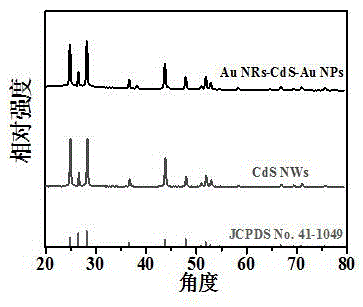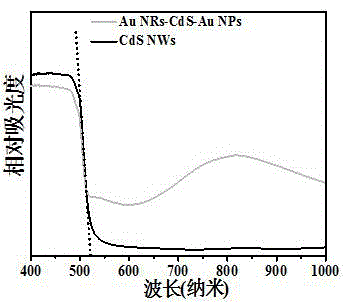Gold nanorod-CdS-gold nanoparticle composite photocatalyst and application thereof
A technology of gold nanoparticles and gold nanorods, which is applied in the gold nanorod-CdS-gold nanoparticle composite photocatalyst and its application field, can solve the problem that the influence of the catalytic performance of the composite photocatalyst has not been comprehensively studied, and achieve the production cost Low, simple production process, high photocatalytic activity and selectivity
- Summary
- Abstract
- Description
- Claims
- Application Information
AI Technical Summary
Problems solved by technology
Method used
Image
Examples
Embodiment 1
[0039] 1.1 Reagents and instruments
[0040] Cetyltrimethylammonium bromide (CTAB), silver nitrate (AgNO 3 ), sodium borohydride (NaBH 4 ), vitamin C (AA), hydrochloric acid solution (HCl, 37wt%), sodium oleate (NaOL) were purchased from SigmaAldrich Reagent Company; cadmium chloride (CdCl 2 2.5H 2 O), sodium diethyldithiocarbamate (C 5 h 10 wxya 2 ·3H 2 O), ethylenediamine (C 2 h 8 N 2) and mercaptoacetic acid (MAA) were purchased from Sinopharm Chemical Reagent Co., Ltd. The experimental water was deionized water. The main instruments are BrukerD8 X-ray powder diffractometer (German Bruker Company), Cary-5000 UV-Vis-Near Infrared Spectrophotometer (US Varian Company), G2F20S-TWIN Transmission Electron Microscope (US FEI Company), ESCALab250 X-ray Photoelectron Energy Spectrum (Thermo Company of the United States), EdinburghFL / FS900 Fluorescence Spectrophotometer (Edinburgh Instruments Company of the United Kingdom), PrecisionPARC Electrochemical Workstation (Amete...
PUM
 Login to View More
Login to View More Abstract
Description
Claims
Application Information
 Login to View More
Login to View More - R&D
- Intellectual Property
- Life Sciences
- Materials
- Tech Scout
- Unparalleled Data Quality
- Higher Quality Content
- 60% Fewer Hallucinations
Browse by: Latest US Patents, China's latest patents, Technical Efficacy Thesaurus, Application Domain, Technology Topic, Popular Technical Reports.
© 2025 PatSnap. All rights reserved.Legal|Privacy policy|Modern Slavery Act Transparency Statement|Sitemap|About US| Contact US: help@patsnap.com



